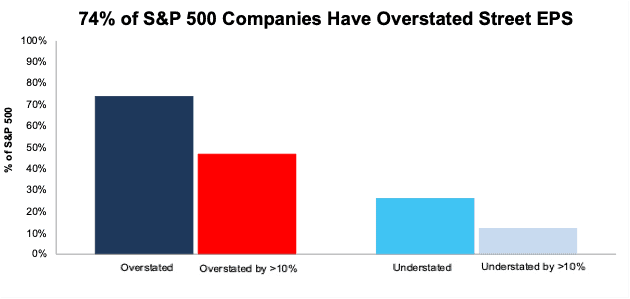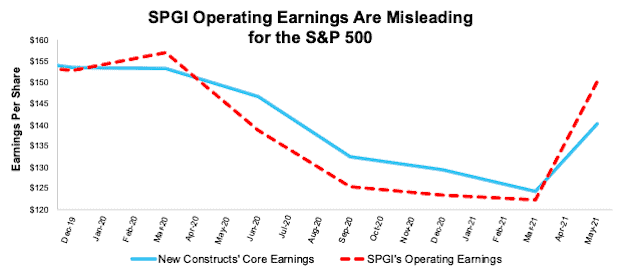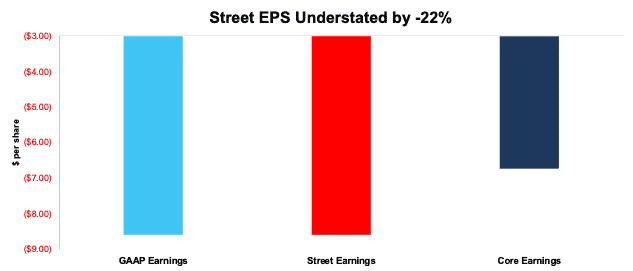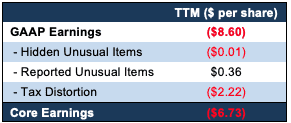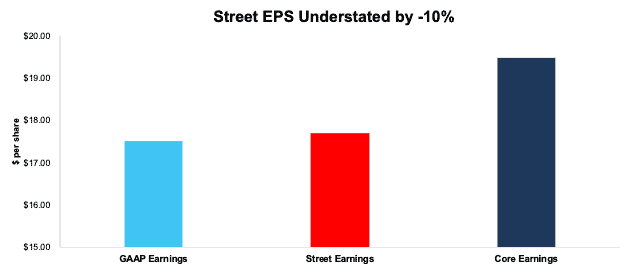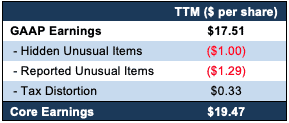In S&P 500 Companies With the Most Misleading Street Earnings, we show the record earnings beats for 1Q21 are misleading, and the Core Earnings of the S&P 500 have not rebounded as strongly as unscrubbed EPS suggest.
In theory, Wall Street analysts adjust Street EPS for unusual gains and losses that distort corporate EPS. In reality, they do not, and Street EPS are materially overstated. We expect companies to continue overstating EPS as they take advantage of the post-COVID-19 euphoria and sneak unusual gains into their results.
This report provides unprecedented insights into why Street Earnings (and GAAP earnings) are flawed measures of earnings, and we highlight five S&P 500 companies likely to beat their calendar 2Q21 Street EPS estimates based on our proprietary Core Earnings research[1]. Clients can get our report on “S&P 500 Companies Likely to Miss Wall Street’s 2Q21 EPS Estimates” here.
47% of the S&P 500 Firms Overstate EPS by >10%
Per Figure 1, 74% of S&P 500 companies have overstated Street EPS, and 26% have understated Street EPS over the trailing twelve months ended calendar 1Q21[2].
47% of S&P 500 companies have overstated EPS compared to our Core EPS by more than 10%, while 12% of S&P 500 companies have understated EPS by more than 10%. When companies overstate EPS, they do so by an average of 31%. When they understate EPS, they do so by an average of 55%.
Figure 1: Street Earnings for the S&P 500 Are Materially Misleading
Sources: New Constructs, LLC and company filings.
Rebound in EPS Is Not As Strong as You Think
Per Figure 2 (from our review of 1Q21 Core Earnings for the S&P 500), Operating Earnings from S&P Global (SPGI) exaggerated the drop in profitability during 2020 and are overstating the rebound in S&P 500 earnings over the last 18 months. I/B/E/S Street Earnings show a similar trend as more companies have overstated Street EPS estimates than understated Street EPS estimates.
Most investors are not aware that SPGI Operating Earnings and Street Earnings suffer from significant flaws when compared to Core Earnings[3], which provide a better measure of earnings because they adjust for material unusual gains/losses missed by Wall Street.
Figure 2: Core Earnings vs. SPGI Operating Earnings: December 2019 to Present (through 5/19/21[4])
Sources: New Constructs, LLC and company filings.
Overstated earnings lead to overstated estimates, which give investors a false view of earnings trends.
How do investors make informed decisions if they don’t know the true earnings of companies?
Five S&P 500 Companies Likely to Beat Calendar 2Q21 Earnings
Figure 3 shows five S&P 500 companies likely to beat calendar 2Q21 earnings based on understated Street EPS estimates. Below we detail the hidden and reported unusual items that have created Street Distortion, and understated Street Earnings, over the TTM for Live Nation (LYV) and Charter Communications (CHTR). Contact us for the same details on the other companies.
Figure 3: Five S&P 500 Companies Likely to Beat 2Q21 EPS Estimates
Sources: New Constructs, LLC and company filings.
*Assumes Street Distortion as a percent of Core EPS equals the same percent in 2Q21 as 1Q21 TTM
What Causes Differences in Earnings Measures
Many investors know that Generally Accepted Accounting Principles (GAAP) contain numerous loopholes that allow companies to manipulate financial statement disclosures. Fewer investors are aware of how much unusual gains and losses, i.e. unusual items, distort Street Earnings and SPGI’s Operating Earnings.
Many investors assume Street Earnings properly adjust for unusual items, but they do not.
This report details the unusual items missed by Street Earnings, which can create overstated earnings and a greater likelihood of missing earnings expectations. Professors from Harvard Business School and MIT Sloan published similar research in The Journal of Financial Economics, which concludes:
“Street Earnings adjustments are not necessarily complete or comparable across firms."
(Page 16, 3rd paragraph)
Live Nation Entertainment’s 2Q21 Street Earnings Estimate Understated by $0.25/share
Live Nation’s 2Q21 Street EPS estimate of -$1.16, which is based on large gains on sales from investments, hidden impairment charges, and tax distortion in historical Street EPS, is understated by $0.25/share. Our Core EPS estimate is -$0.91, and the understated Street EPS estimate increases the likelihood that Live Nation’s Core EPS will beat Wall Street analysts’ expectations in its calendar 2Q21 earnings report.
Unusual items, which we detail below, materially distorted Live Nation’s 1Q21 TTM Street and GAAP Earnings and artificially make losses look worse than Core EPS. When we adjust for all unusual items, we find that Live Nation’s 1Q21 TTM Core EPS are -$6.73, which is better than 1Q21 TTM Street and GAAP EPS of -$8.60.
Figure 4: Comparing Live Nation’s Core, Street, and GAAP Earnings: TTM as of 1Q21
Sources: New Constructs, LLC and company filings.
Below, we reconcile the differences between Live Nation’s 1Q21 TTM Core Earnings and GAAP Earnings so readers can audit our work. We cannot reconcile Core Earnings to Street Earnings because we do not have the details as to exactly what makes Street Earnings differ from GAAP Earnings.
Figure 5: Live Nation’s GAAP Earnings to Core Earnings Reconciliation: TTM as of 1Q21
Sources: New Constructs, LLC and company filings.
Hidden Unusual Expenses, Net = -$0.01/per share, which equals -$1 million
- -$13.5 million in impairment charges related to definitive-lived intangible assets in the TTM period, based on
- -$3.6 million in 3Q20
- -$9.9 million in 4Q20
- $12.2 million in sublease income in the TTM period, based on
- $9.9 million from 2Q20-4Q20 based on $13.3 million reported on Page 73 2020 10-K
- $2.3 million in 1Q21
Reported Unusual Gains, Net = $0.36/per share, which equals $77 million
- $56 million gain from sale of investments in nonconsolidated affiliates – 1Q21 10-Q
- $22 million in other income in the TTM period, based on
- $5 million in 2Q20
- $11 million in 3Q20
- $6 million in 4Q20
- $0.01 million in 1Q21
- -$0.5 million in losses on disposal of operating assets in the TTM period, based on
- -$0.6 million in 2Q20
- -$0.2 million in 3Q20
- $0.4 million in 4Q20
- -$0.2 million in 1Q21
Tax Distortion = -$2.22/per share, which equals -$473 million
- We remove the tax impact of unusual items on reported taxes when we calculate Core Earnings. It is important that taxes get adjusted so they are appropriate for adjusted pre-tax earnings.
Charter Communications’ 2Q21 Street Earnings Estimate Understated by $0.49/share
Charter’s 2Q21 Street EPS estimate of $4.86, which is based on hidden costs associated with COVID-19 and what the company refers to as “special charges” in historical Street EPS, is understated by $0.49/share. Our Core EPS estimate is $5.35, and the understated Street EPS estimates increase the chance that Charter’s Core EPS will beat Wall Street analysts’ expectations in its calendar 2Q21 earnings report.
The unusual items detailed below materially distorted Charter’s 1Q21 TTM Street and GAAP EPS and artificially lower profitability. When we adjust for all unusual items, we find that Charter’s 1Q21 TTM Core EPS are $19.47, which is well above 1Q21 TTM Street EPS of $17.69 and 1Q21 TTM GAAP EPS of $17.51.
Figure 6: Comparing Charter’s Core, Street, and GAAP Earnings: TTM as of 1Q21
Sources: New Constructs, LLC and company filings.
Below, we reconcile the differences between Charter’s TTM Core Earnings and GAAP Earnings so readers can audit our work. We cannot reconcile Core Earnings to Street Earnings because we do not have the details as to exactly what makes Street Earnings differ from GAAP Earnings.
Figure 7: Charter’s GAAP Earnings to Core Earnings Reconciliation: TTM as of 1Q21
Sources: New Constructs, LLC and company filings.
Hidden Unusual Expenses, Net = -$1.00/per share, which equals -$208 million
- -$208 million in the TTM period based on -$277 million in non-operating expense related to customer credits due to COVID-19 – Page 35 2020 10-K
Reported Unusual Expenses, Net = -$1.29/per share, which equals -$268 million
- -$329 million in “special charges” in the TTM period, based on
- -$6 million in 2Q20
- -$28 million in 3Q20
- -$40 million in 4Q20
- -$255 million in 1Q21
- $221 million extinguishment of debt and gains on financial instruments in the TTM period, based on
- -$36 million loss on extinguishment of debt in 2Q20
- $64 million gain on financial instruments in 2Q20
- -$58 million loss on extinguishment of debt in 3Q20
- $69 million gain on financial instruments in 3Q20
- $163 million gain on financial instruments and extinguishment of debt in 4Q20
- -$29 million loss on extinguishment of debt in 1Q21
- $48 million gain on financial instruments in 1Q21
- -$55 million in the TTM period based on -$55 million loss on foreign currency remeasurement of Sterling Notes to U.S. dollars – 2020 10-K
- -$52 million in reported other non-operating expenses in the TTM period, based on
- $11 million other pension benefits in 2Q20
- -$115 million other pension costs in 3Q20
- $19 million other pension benefits in 4Q20
- $18 million other pension benefits in 1Q21
- $15 million gain on equity investments in 1Q21
- -$47 million loss on disposal of assets – 1Q21 10-Q
- $40 million in the TTM period based on $40 million gain on the change in fair value of cross-currency derivative instruments – 2020 10-K
- -$38 million contra adjustment for recurring pension costs. These recurring expenses are reported in non-recurring line items, so we add them back and exclude them from Earnings Distortion.
- -$31 million in “other expense” in the TTM period, based on
- -$9 million in 2Q20
- -$13 million in 3Q20
- -$9 million in 4Q20
- $23 million in gain on sale of assets in the TTM period, based on
- $4 million in 2Q20
- $14 million in 3Q20
- $5 million in 4Q20
Tax Distortion = $0.33/per share, which equals $68 million
- We remove the tax impact of unusual items on reported taxes when we calculate Core Earnings. It is important that taxes get adjusted so they are appropriate for adjusted pre-tax earnings.
Conclusion: Core Earnings Are More Reliable
As demonstrated above, Core Earnings do a better job of excluding unusual gains and losses and provide a more reliable earnings measure. All Core Earnings adjustments to GAAP Earnings are 100% transparent; so users can audit and trust the research.
A lack of transparency into exactly what makes up Street Earnings and SPGI’s Operating Earnings undermines investors’ ability to analyze profitability. In theory, the differences between Core Earnings and GAAP Earnings should be captured in Street Earnings and SPGI’s Operating Earnings. In theory, they adjust GAAP Earnings for both reported and hidden unusual items. In reality, they do not consistently adjust for unusual items.
For many investors, especially quants, the lack of consistency in what Street Earnings and SPGI’s Operating Earnings capture is worse than the lack of completeness.
This article originally published on July 13, 2021.
Disclosure: David Trainer, Kyle Guske II, Alex Sword, and Matt Shuler receive no compensation to write about any specific stock, style, or theme.
Follow us on Twitter, Facebook, LinkedIn, and StockTwits for real-time alerts on all our research.
[1]The Journal of Financial Economics proves that only Core Earnings enable investors to overcome the flaws in legacy fundamental data.
[2] The most recent Core Earnings and Street Earnings values are based on the latest audited financial data from calendar 1Q21 10-Qs.
[3]As proven in Core Earnings: New Data & Evidence, a paper in The Journal of Financial Economics, only Core Earnings enable investors to overcome the flaws in legacy fundamental data and research.
[4] The earliest date that the 1Q21 10-Qs for all S&P 500 constituents were available.
[5] While we can explicitly reconcile Core Earnings to GAAP Earnings, we cannot do the same for Street Earnings because analysts do not publicly disclose what is captured in Street Earnings.
[6] For unusual items found only in the latest 10-K, we show the amount applied to TTM calculation and link to the disclosure in the 10-K.
[7] While we can explicitly reconcile Core Earnings to GAAP Earnings, we cannot do the same for Street Earnings because analysts do not publicly disclose what is captured in Street Earnings.
[8] For unusual items found only in the latest 10-K, we show the amount applied to TTM calculation and link to the disclosure in the 10-K.

